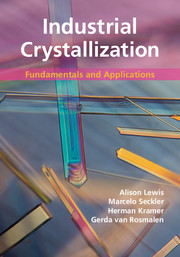Book contents
- Frontmatter
- Contents
- Nomenclature
- Industrial crystallization in practice: from process to product
- 1 Thermodynamics, crystallization methods and supersaturation
- 2 Characterization of a crystalline product
- 3 Basic process design for crystallization
- 4 Nucleation
- 5 Crystal growth
- 6 Agglomeration
- 7 The population balance equation
- 8 Batch crystallization
- 9 Measuring techniques
- 10 Industrial crystallizers
- 11 Precipitation and anti-solvent crystallization
- 12 Melt crystallization
- 13 Additives and impurities
- 14 Polymorphism
- Index
- References
7 - The population balance equation
Published online by Cambridge University Press: 05 July 2015
- Frontmatter
- Contents
- Nomenclature
- Industrial crystallization in practice: from process to product
- 1 Thermodynamics, crystallization methods and supersaturation
- 2 Characterization of a crystalline product
- 3 Basic process design for crystallization
- 4 Nucleation
- 5 Crystal growth
- 6 Agglomeration
- 7 The population balance equation
- 8 Batch crystallization
- 9 Measuring techniques
- 10 Industrial crystallizers
- 11 Precipitation and anti-solvent crystallization
- 12 Melt crystallization
- 13 Additives and impurities
- 14 Polymorphism
- Index
- References
Summary
Why this chapter is important
The prediction of the product quality in industrial crystallization processes is not simple and requires detailed knowledge of the crystal size distribution (CSD). To obtain such knowledge, the population balance equation (PBE) has to be solved, describing the evolution of the CSD in the crystallizer.
In this chapter PBE-based models of the crystallization process will be discussed in detail, describing the formulation of the PBE based on either the length or the volume of the crystals, explaining the different terms of this important equation and their relation to the different kinetic processes in the crystallizer. Growth- and nucleationdominated systems and processes that are predominantly agglomeration and breakage will be discussed separately, as they require a different formulation. The coupling of the population to the enthalpy and material balances, to obtain a realistic description of the process is discussed, as well as solution methods for a PBE-based crystallizer model. Multi-compartment models are also introduced that can be used to describe the effects of profiles in the process conditions on the performance of an industrial crystallizer, due to the large volume or complex geometry. A few examples of such multi-compartment models are given.
Having a crystallization model is extremely valuable for the development, optimization and design of a process that meets specific product requirements. To be more precise, having a PBE-based crystallization model will allow the user
• to predict the resulting particle size distribution even at a different scale of operation, on the basis of the known kinetic models;
• to estimate the parameters of a kinetic model based on an experimentally determined particle size distribution knowing the process conditions under which it was obtained;
• to optimize the process conditions to obtain a desired particle size distribution given a validated kinetic model.
Evolution of the crystal size distribution in a crystallizer
A crystalline product consists of a distribution of crystals (or of agglomerates of crystals that are often referred to as particles) of different sizes.
- Type
- Chapter
- Information
- Industrial CrystallizationFundamentals and Applications, pp. 151 - 177Publisher: Cambridge University PressPrint publication year: 2015
References
- 1
- Cited by



